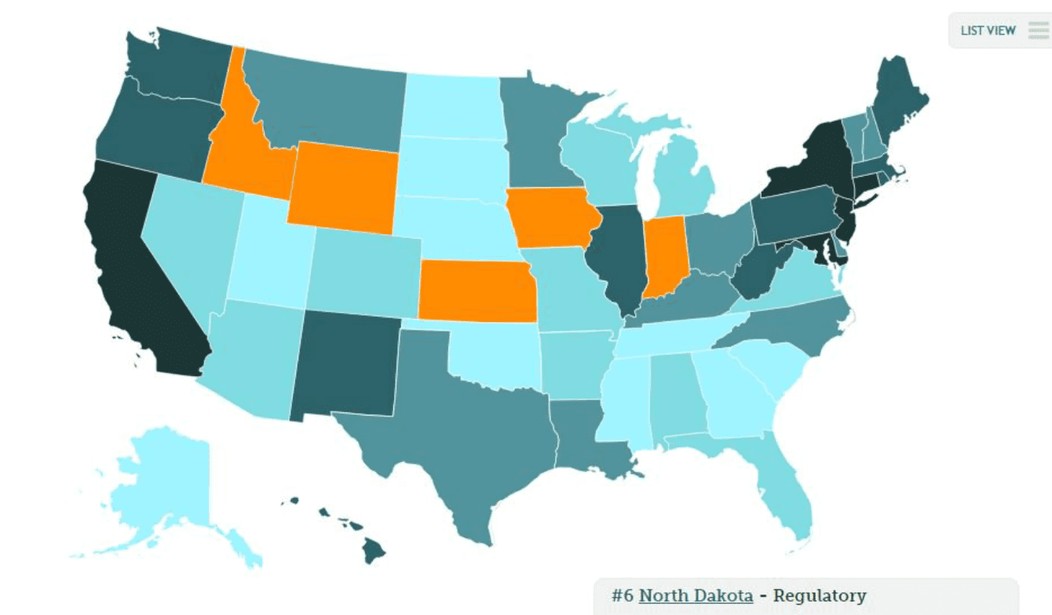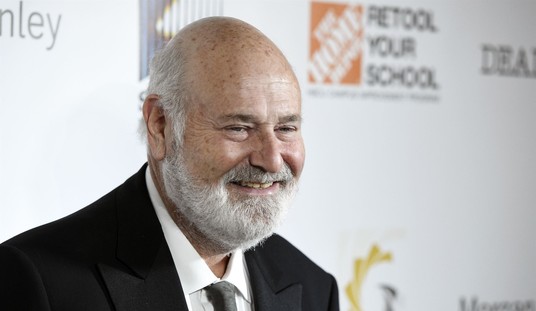This week, the Cato Institute released its 2016 rankings for “Freedom in the 50 States.” The list includes each state, ranked on a long list of variables, ranging from taxes, to alcohol and tobacco, to gun control and the right to work.
The Cato Institute is a libertarian think tank, so the rankings favor issues like gay marriage and marijuana legalization, and lower incarceration rates, in addition to conservative issues like school choice, taxes, and regulation. The rankings mention “deep blue” states, which score low on economic freedom and high on personal freedom, and “deep red” states, which score high on economic but low on personal freedom. Overall, economic and regulatory freedom matter most for Cato, and for libertarians in general.
Without further ado, here are the 5 least free states, followed by the 5 freest. Enjoy!
50. New York.
Perhaps not surprisingly, New York State’s fiscal policy makes it the least free state in the nation. The local tax burden is twice that of the average state, at 7.8 percent of income. The state tax burden, at a projected 6.7 percent of income, is also higher than the national average. Debt is the highest in the country — 31.9 percent of income. New York spends almost four times what the average state does on business subsidies.
The Empire State is also the worst state for regulatory policy, with tight restrictions on rent control, a state minimum wage, and unreformed cable and telecommunications laws. The state did receive positive marks for low incarceration rates, gay marriage legalization in 2011, and medical marijuana.
Sadly, New York is the worst state for homeschoolers, and has no private school choice programs. All fireworks are banned. Smoking bans combine with high cigarette taxes to make New York the worst for tobacco freedom as well. Gun rights are heavily restricted.
49. California.
Again, California’s low levels of economic freedom far outbalance its personal freedom, from the Cato standpoint. It is one of the highest-taxed states — combined state and local taxes reached 10.8 percent of personal income.
Cato describes California’s labor law as “anti-employment,” with no right-to-work, high minimum wages, strict workers’ comp mandates, mandated short-term disability insurance, and a strict anti-discrimination law. Occupational licensing is strict.
Not surprisingly, guns are highly regulated, private school choice programs are nonexistent, and homeschooling is moderately regulated. California gets high marks for less regulated alcohol, falling incarceration rates, and early adoption of civil unions.
Next Page: This tourist state has high temperatures — and regulations.
48. Hawaii.
Both economic and personal freedom are declining in Hawaii, and it has experienced net outflow of residents to other states since 2000. State-level taxes have risen to 9.3 percent, while local taxes are high, considering local government does not even provide education.
Hawaii has strict restrictions on building, high rates of eminent domain abuse, and a rising minimum wage. It has no right-to-work law and strict mandates on work. The state is also one of the most “cronyist” states, with highly regulated occupational licensing, a price-gouging law, and an “unfair sales” law, which prevents people from selling at prices that are “too low.” The legal sector has shrunk, however.
Incarceration rates are low, but drug enforcement is increasing. Cigarette taxes, smoking bans, high beer taxes, and a ban on “happy hours” combine with gun restrictions to make Hawaii a bad state for personal freedom as well.
47. New Jersey.
New Jersey was once a tax haven, but it now has shifted heavily against economic freedom. Tax refugees from New York still go there, but many more now move to Florida. State taxes are higher than average, but local taxes are much higher than average. Government subsidies and debt are also above average.
The state also has restrictive zoning laws, a minimum wage, workers’ compensation rules, mandated family leave, and a strict anti-discrimination law. Occupational licensing is about average, but insurance regulation is strict.
New Jersey gets better marks for personal freedom, but even these are mixed. Incarceration rates are down, alcohol freedom is above average, and homeschools and private schools are barely regulated. On the flipside, guns are highly regulated, politicians can extract rents from alcohol sales, and there are no public or private school choice programs.
46. Maryland.
Maryland’s taxes are about average, but they have risen over time. The state is less indebted than other states, but it spends more than average on business subsidies. Bad zoning laws, unchecked eminent domain, and a new minimum wage also count against the state. Occupational licensing is high, and insurance is also very regulated.
While average on criminal justice, the state’s civil asset forfeiture law is stronger than average. High cigarette taxes encourage smuggling, but the state has generally low taxes on alcohol. Homeschooling and private schools are highly regulated, as are firearms.
Next Page: Enough of the five worst. Which states are the best?
5. South Dakota.
South Dakota has one of the lowest tas burdens in the country, and both local and state taxes have fallen over time. Subsidies and debt are well below national averages, and public employment is also below it. Zoning laws are lax, and labor laws are strong — the Mount Rushmore State has a right-to-work law but also a high minimum wage. Occupational licensing is below the national average, but has increased with time. The civil liability system is also a count on the state’s favor.
The Mount Rushmore State’s high incarceration rates, unreformed civil asset forfeiture, and harsh marijuana laws run afoul of Cato on personal freedom. But private school and homeschool regulations are less burdensome than some, but it lacks school choice programs. Tobacco taxes are high, but alcohol freedom is extensive. South Dakota is one of the best states for gun rights.
4. Indiana.
The Hoosier State is the freest state in the Great Lakes region. In recent years, local taxes and government debt both fell. Government subsidies and employment are smaller than the national average.
Obamacare has damaged Indiana’s previously free-market health insurance policies, but its regulatory freedom is improving otherwise: Land-use freedom is high, the state massed right-to-work legislation, and it is a model for telecom deregulation. Even insurance freedom is high, and the civil liability system has shown steady improvement. Occupational licensing is high, but does not extend to come health care professions.
Indiana also has more personal freedom than most other conservative states, according to Cato. It never had a state marriage law, legal gambling is extensive, and marijuana and alcohol freedom are better than average. Educational freedom is excellent, with a new voucher law and a limited scholarship tax credit. Gun rights are secure, especially for concealed carry, despite a few bad regulations.
3. Oklahoma.
The Sooner State is the most improved between 2000 and 2014. One of the least taxed states in the nation, Oklahoma also has lower government subsidies and much lower debt than average. Impressively, the state has been able to cut its debt even as tax receipts fell as a share of the economy.
Zoning laws are lax, although the state has not restrained the use of eminent domain. Oklahoma is a right-to-work state, without a minimum wage and with lighter worker’s compensation mandates than most states. Insurance freedom is high, and tort reforms in the 1990s and 2000s have greatly improved the court system.
Oklahoma’s incarceration rate is very high, but victimless crime (a libertarian category that includes drugs and prostitution, among other crimes) arrests have been declining. The state has many alcohol regulations, including a happy hour ban, a ban on direct wine shipment, and a ban on wine and spirits in grocery stores. Education freedom has increased, with a voucher law and modest tax benefit for contributions to private scholarship funds. Homeschools and private schools are virtually unregulated.
Next Page: The two freest states in the union … are both way up north?!
2. Alaska.
Alaska’s tax policies are tied to commodity markets, and its fiscal policy fluctuates wildly with the price of oil. It has an enormous rainy-day fund, which was necessary when corporate income tax collection plummeted following the end of the commodity boom in the late 2000s. This means the tax rate is low for now. Over 25 percent of the state’s employed population works in government, and it spends more than the national average on business subsidies.
The Last Frontier State has a very regulated labor market, without a right-to-work law, with strict workers’ compensation mandates, and a high minimum wage. Occupational licensing is high, and insurance is tightly regulated. Yet Alaska gives freedom to health professionals, has lax zoning laws, and has one of the nation’s best civil liability systems.
Alaska’s personal freedom is its most impressive quality. Incarceration rates are below the national average, marijuana is legal, and homeschooling is unregulated. Gun rights are so secure that the concealed carry of handguns does not even require a license! While the state had one of the most anti-gay-marriage laws in the country, it was overturned. Alaska’s civil asset forfeiture law leaves local police almost entirely unchecked, requiring the owner of seized property to prove innocence. Sales of all alcohol are prohibited in grocery stores and beer taxes are very high.
1. New Hampshire.
The Granite State taxes less than any other state besides Alaska. The state tax is approximately 2.8 percent today. Local taxes are higher, making the state fiscally decentralized. Government subsidies, debt, and employment are all lower than the national average, and have dropped even further between 2010 and 2014.
New Hampshire’s residential building restrictions are tough, however. The state also has below average labor market freedom, because there is no right-to-work law, even though it has no minimum wage. The Granite State proves above average on checking the abuse of eminent domain, deregulation of telecommunications, on insurance freedom, and on occupational licensing. The civil liability system is also better than the national average.
Incarceration rates and drug arrest rates are low, and New Hampshire was among the first states to legalize civil unions and gay marriage. Cigarette taxes are high, but alcohol restrictions are about average. There is no public school choice, and private schools require state approval, but a liberal tax credit scholarship law broadened educational freedom in recent years. The Granite State remains, however, one of the best states in the country on gun rights, with easily obtainable open and concealed carry permits.
Bonus: Why is Texas ranked so low?!
Texas … number 28?!
Texas is known for its free economy, its burgeoning jobs market, and its growing population. But its economic growth rate in the past 15 years has lagged behind the Dakotas, Utah, and Wyoming which have also benefitted from the shale revolution.
Lone Star state taxes are well below the national average, but debt is above average, with local debt causing big problems. Public employment has fallen and government subsidies are low.
Texas has lax zoning laws and is the best state for labor market freedom. Workers’ compensation coverage is optional for employees (even so, most employees are covered), the state has a right-to-work law, and no minimum wage. Telecommunications have been liberalized, but occupational licensing and health insurance mandates are high. The civil liability system was horrible, but has improved.
The biggest weight driving the Lone Star State down, in Cato’s estimation, is personal freedom. The incarceration rate is very high, as are drug arrest rates. Civil asset forfeiture is mostly unreformed, and marijuana laws are very harsh. For such a conservative state, Texas has no private school choice programs, but private schools and homeschools are unregulated. Gun rights are above average and should improve with the new open carry law. Tobacco freedom is moderate and alcohol freedom is above average. A final mark in the Lone Star State’s favor is its lack of campaign finance regulations.




















Join the conversation as a VIP Member